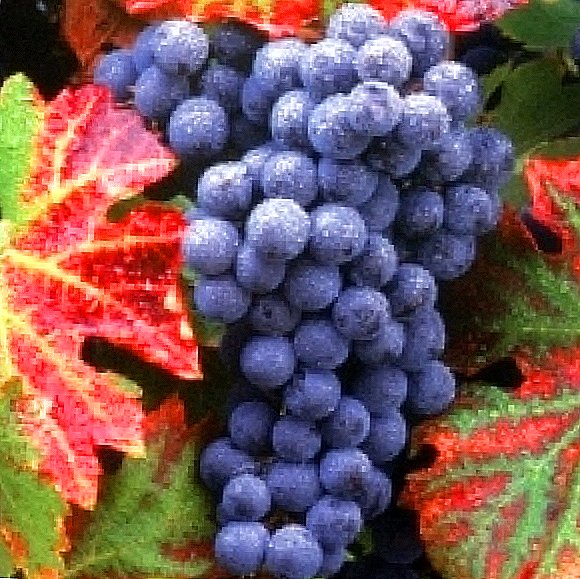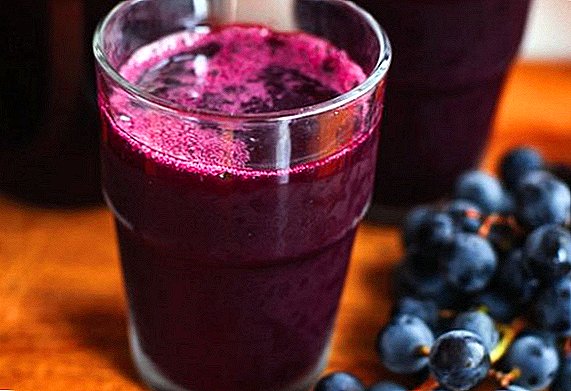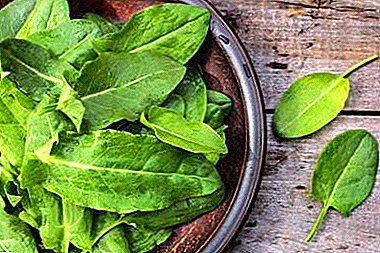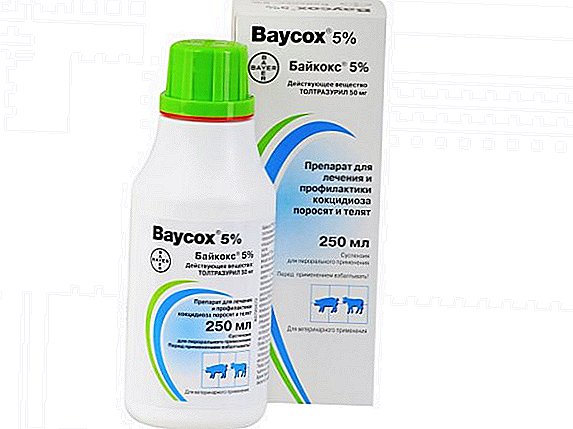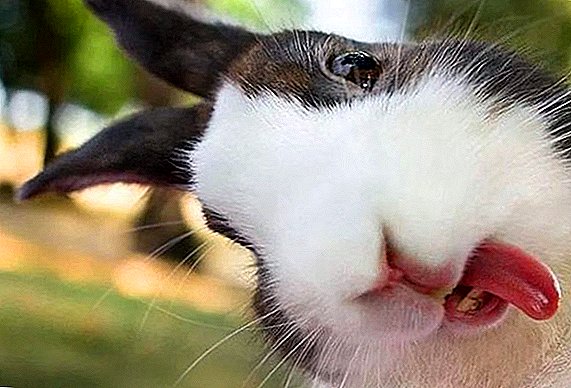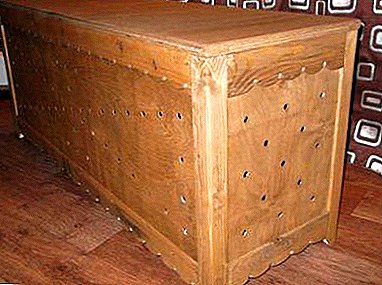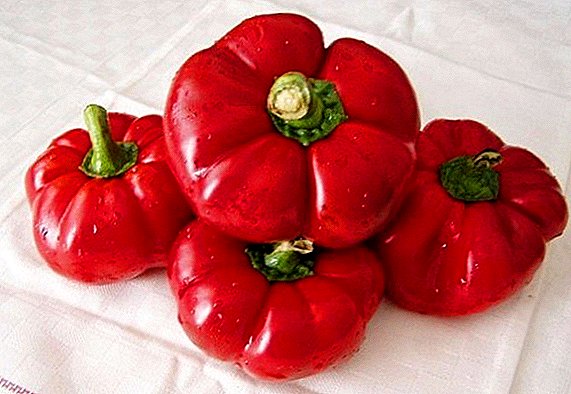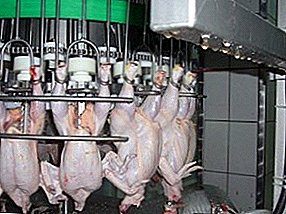
Slaughter of poultry is one of the most important moments in the preparation of meat. Its taste and nutritional properties, as well as its shelf life, largely depend on how the slaughter was made.
Any mistake made during the time of killing the birds may adversely affect the quality of the meat, and it will be rejected by the purchasers.
Before direct killing chickens carefully prepared. This greatly facilitates the subsequent plucking of fluff and the processing of meat.
In addition, good preparation of chickens during life significantly increases the shelf life of meat.
How are chickens killed at a poultry farm?
To remove all the leftover food and feces from the chicken food line, poultry workers no longer feed them. The pre-slaughter period may begin 18-24 hours before the immediate slaughter.
Also it is very important to stop giving water to chickens. Approximately 10 hours before the killing of the birds stop to drink. This allows the excess water, which remains in the digestive organs, to gradually evaporate.
Hungry chickens suffering from thirst can peck their litter in order to somehow survive the lack of food and water. That is why, before slaughter, they must be kept in cells with a mesh floor. When the chickens will defecate, the litter will begin to fall on a special litter and they will not be able to peck at it.
Catching
 Few people know that properly made catching chickens, as well as their landing in a shipping container, significantly improve the quality of future meat carcasses.
Few people know that properly made catching chickens, as well as their landing in a shipping container, significantly improve the quality of future meat carcasses.
As a rule, catching birds occurs in a relaxed atmosphere. This is done in order to prevent the bird from breaking its wings and legs and to get bruises that worsen the presentation of the carcass.
According to experts, 90% of bruises on broiler carcasses appear during the period of catching and transporting poultry.. It was also noticed that more muscular broilers have more bruises.
In the event that the birds are kept in a floor growing system, red light is used during the capture. He reassures the bird, so it does not even try to run away when they want to catch it. As for the birds living in cages, they are unloaded manually, and then transplanted into the container for transportation to the shop, where they are slaughtered.
Transportation to the place of slaughter
 During the transportation of still living birds, high-quality equipment is used, which can provide adequate livestock conditions for the livestock.
During the transportation of still living birds, high-quality equipment is used, which can provide adequate livestock conditions for the livestock.
Containers are used for transportation, where temperature conditions and ventilation are well maintained. Such containers have additional protection from sun, rain and other adverse weather conditions for the bird.
Before planting a bird in a container, it is necessary to take into account its size, since the density of planting of different breeds may vary. On average, the density of planting of hens of egg breeds should not exceed 35 heads / sq. m, meat - 20 heads / sq.m, broiler chickens - 35 heads / sq.m.
The density of poultry landing depends on weather conditions and temperature conditions. If the air temperature exceeds +250 C, then this figure should be reduced by 15 or 20%, since in a tight container the chickens may not have enough fresh air.
Most often for the transport of livestock used boxes made of wood. They have a dense floor that allows the bird to feel comfortable.
Also for these purposes are used stationary and removable containers. They are placed in special poultry carriers - large trucks, having a trailer. In them, cells and containers are arranged in advance where the birds will be during transportation.
 Chickens Padua in the photo does not look very nice. You may not agree with me, but not after seeing them live.
Chickens Padua in the photo does not look very nice. You may not agree with me, but not after seeing them live.All stages of chickens raising with a hen are available on our website here.
Some poultry farms use tractor traction to transport chickens. However, this method is suitable only if the livestock needs to be transported for a short distance.
Foreign poultry farms are often used. plastic boxes for transporting chickens for slaughter. They are made in such a way that during unloading it is not necessary to remove the bird from its cages. Simply push the floor and the bird will fall on the conveyor, which supplies it to the slaughterhouse.
The structure of the container for the transport and loading of birds
 Each container used to transport chickens consists of a frame with a fencing of a twig.
Each container used to transport chickens consists of a frame with a fencing of a twig.
This container has two sections, each of which can accommodate six cells with a movable bottom. It also has comfortable wheels that make it easy to move the birds around the workshop if necessary.
Bird loading always starts from the top of the container.. To do this, move all the bottom, except the lowest. As the container is filled, the bottoms are alternately pushed. Additionally, you can load the bird through the convenient side doors.
Such a container can transport from 120 to 180 birds at a time. On the automobile trailer usually establish 24 such containers. They can accommodate a total of 3,000 to 4,200 heads.
That is why the transport of birds in the container is much more efficient than in the box. It not only significantly reduces the amount of damage to the bird, but also allows you to transport a much larger number of heads. At the same time, workers spend much less time and effort on loading.
To reduce stress in birds during transportation, it is necessary to reduce the delivery radius to 50 km. In this case, the chickens must be in containers for no more than 8 hours, otherwise they may become nervous, which often leads to the occurrence of various injuries.
It is necessary to know that the movement of poultry in the country becomes possible only if there is veterinary control. Every driver involved in transportation must have a veterinary certificate and a bill of lading.
Preparation in the workshop
 Arriving at the slaughterhouse, the bird is carefully sorted. Receivers count the number of heads, measure the live weight, determine the type, age and fatness of chickens in accordance with existing standards. At the same time, a representative of the slaughterhouse and the deliverer must be present.
Arriving at the slaughterhouse, the bird is carefully sorted. Receivers count the number of heads, measure the live weight, determine the type, age and fatness of chickens in accordance with existing standards. At the same time, a representative of the slaughterhouse and the deliverer must be present.
Chickens of the same breed and same age are placed in each cage.. Then it is sent to the scales, where the live weight of the bird is determined. After that, the delivery-acceptance of the chickens is made using the invoice, which is signed by the deliverer and the receiver. It also indicates the number of dead birds.
After signing the invoice, you can start the immediate slaughter of chickens. To do this, the bird is fed to the processing conveyor. There it is fixed to the legs in special forceps, pendants back to the worker.
Immediately after that, the birds are fed to the electric stunning apparatus. With the help of high-voltage electrical current, the bird is brought into immovable state. It stops twitching, which significantly reduces the risk of various injuries.
Usually, 550 or 950 V is used for stunning. The current is supplied to the bird through the water, and the total duration of the stun never exceeds 5 seconds.
If the stress is high, then the bird can disrupt the activity of the heart, which is fatal.
Exsanguination
 Immediately after stunning, the birds are served in the shop, where bleeding is carried out. This operation must be performed no later than 30 seconds after stunning. In some cases, this procedure takes place without stunning.
Immediately after stunning, the birds are served in the shop, where bleeding is carried out. This operation must be performed no later than 30 seconds after stunning. In some cases, this procedure takes place without stunning.
Slaughter is considered the most effective method of slaughtering chickens. through the mouth with a narrow sharp knife or scissors with pointed ends.
The worker takes the hanging chicken with his left hand and opens his mouth. With his right hand, he abruptly inserts a knife into an open beak. It is important to get to the left corner of the pharynx, where the jugular and pavement veins are connected. Immediately after that, an injection is made in the brain and palatine cavity. Such actions quickly paralyze the bird and weaken the muscles that hold the feathers on its body.
After slaughter, the knife is removed and the chicken hangs upside down for 15-20 minutes. This is done to ensure that all the blood is glass of their carcass. At the same time it is important not to forget to spread the wings, since blood often lingers in them, forming hematomas.
Also, the presence of blood in the chicken carcass can lead to a significant reduction in shelf life. Often, pathogenic microorganisms are found in the blood, so it is important to carry out bleeding qualitatively.
Heat treatment
 Immediately after completing the bleeding process, the hens carcass is fed to a heat treatment apparatus.
Immediately after completing the bleeding process, the hens carcass is fed to a heat treatment apparatus.
This stage is necessary for more successful removal of feathers from the body of chickens. When the carcass is sharpened, the muscles that hold the bird's feather relax, so feather plucking is easier.
After that, the chickens are sent to the workshop where the plucking is done using machines. Immediately, it should be noted that the carcass can be cooked only at the optimum temperature, as very hot steam can damage the skin of chickens.
In the conditions of large poultry farms can be used soft and hard cogger modes. When using the soft mode, the stratum corneum of the epidermis is partially damaged, and the germ layer and skin remain intact. Such carcasses have a marketable appearance, but they are more difficult to handle, since the plumage is more strongly retained on the skin.
With a stiff scarf all the plumage on the body of the chicken is removed by machines. Almost never requires additional treatment, but with this method of treatment the epidermis and partially the skin are completely damaged.
After that, it is removed and the skin of the carcass becomes more sticky and pink. In appearance, the meat often does not meet current standards, but if they undergo additional freezing, they will become similar to meat that has undergone soft heat treatment.
It is important to know that meat processed in the soft mode can be stored much longer than the one that has undergone tough processing. The fact is that on the surface of such carcasses there is no favorable environment for the life of microorganisms, so they can be stored for a long time in the refrigerator.
Gutting
 Immediately after steaming, the chickens are sent for gutting. It is not removed from the conveyor.
Immediately after steaming, the chickens are sent for gutting. It is not removed from the conveyor.
The intestines are removed with a special knife and the cloaca is completely cut out. Then the carcass is placed on the cutting table with the head away from the worker, with his stomach up.
It is a longitudinal section from the cloaca to the keel. Immediately after this, the intestine is removed, but it is necessary to separate the end of the duodenum from the stomach so that the intestine does not burst. After removing the intestines, the carcass is washed with water.
In the chickens, the legs in the joints joint are additionally separated.. This is done using a special machine, but the separation can also be done manually. To do this, the carcass is taken with his left hand and the quick horizontal movement of the right hand cuts all the tendons and interrupts the joint.
Cooling
 Immediately after gutting, the chicken carcasses are cooled.
Immediately after gutting, the chicken carcasses are cooled.
This contributes to the better maturation of meat, and also prevents the progress of various microbiological processes. Cooling occurs using cold water in cooling tanks.
In it, the meat is fascinated by the flow of water and enters the rotating drums. The process itself lasts an average of 25 minutes. Immediately after this, the carcasses are packed in containers for sale.
In addition to the carcasses of chickens, it is necessary to cool edible by-products: heart, liver, stomach and neck. After cooling, they are folded into plastic film bags or special wipes made of polyethylene.
Conclusion
Chicken slaughter is a complex process that consists of many stages. All its stages must be carried out correctly, as the quality of the meat depends on it.
Any mistake made during the preparation for slaughter and during the immediate slaughter can cause serious financial losses. That is why this process should be treated with the utmost responsibility.


